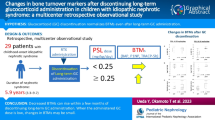Abstract.
It is widely known that glucocorticoids induce and accelerate osteoporosis. High-dose glucocorticoids are administrated daily to patients in the acute phase of nephrotic syndrome. It could be inferred that high-dose glucocorticoids rapidly decrease patients' basal bone mineral density (BMD) and this accelerates the natural progress of osteoporosis associated with aging or menopause. Nine nephrotic patients (male/female: 5/4) without previous prednisolone administration were chosen to measure BMD and the level of the markers for bone turnover before and after treatment for 3 months (total prednisolone administration: 4.5 ± 0.0 g). Twenty-three patients under remission with prednisolone administration (male/female: 14/9) were included in the long-term treatment group. Patients in this group whose %YAM in the lateral lumbar spine was less than 89% were classified into a low BMD group (n = 10, male/female: 3/7). They were administered etidronate disodium at 200 mg/day for 14 days. BMD and % of young adult mean (YAM) in the lumbar spine (L2-L4 in lateral objection) and other regions were measured by dual-energy X-ray absorptiometry. As markers of bone metabolism, the urinary level of deoxypyridinoline (Dpd) was determined to evaluate osteogenesis, and serum osteocalcin was measured to evaluate bone resorption. BMD of the lumbar spine significantly decreased in the 3-month treatment group (752 ± 96 mg/cm2, 7 ± 4% reduction) compared with the pretreatment group (810 ± 85 mg/cm2). BMD in the long-term treatment group decreased continuously (683 ± 135 mg/cm2). No significant differences were noted in other measurement sites. BMD in the etidronate treatment group increased significantly (597 ± 55 mg/cm2) compared with the pretreatment group (549 ± 76 mg/cm2). Etidronate did not change BMD at the sites with a normal BMD. Among the biochemical markers (BM) examined, the urinary level of Dpd (nMol/liter · Cr) significantly increased in the 3-month treatment group (8.6 ± 5.1 nMol/liter·Cr) compared with the pretreatment group (5.8 ± 2.0 nMol/liter · Cr). No significant differences were seen in the BMs measured in the long-term treatment group. The urinary Dpd level of the etidronate treatment group decreased (3.9 ± 1.4 nMol/liter · Cr) compared with the pretreatment group. These data indicate that etidronate could improve the accelerated bone resorption. In conclusion, high-dose glucocorticoid therapy causes rapid bone resorption and accelerates the natural progress of osteoporosis associated with aging or menopause. Etidronate administration prevents the progress of osteoporosis in nephrotic patients. Preventive treatment should be performed when the estimated BMD in 3 months falls below the baseline by more than 7 ± 4%, reaching the therapeutic range.
Similar content being viewed by others
Author information
Authors and Affiliations
Additional information
Received: 31 March 1999 / Accepted: 29 September 1999
Rights and permissions
About this article
Cite this article
Fujita, T., Satomura, A., Hidaka, M. et al. Acute Alteration in Bone Mineral Density and Biochemical Markers for Bone Metabolism in Nephrotic Patients Receiving High-Dose Glucocorticoid and One-Cycle Etidronate Therapy. Calcif Tissue Int 66, 195–199 (2000). https://doi.org/10.1007/s002230010039
Issue Date:
DOI: https://doi.org/10.1007/s002230010039




